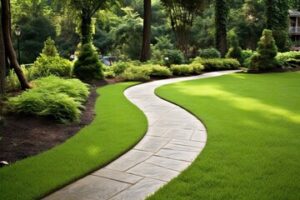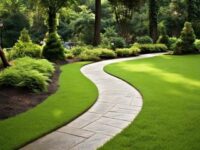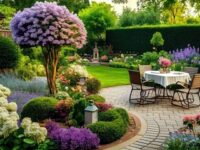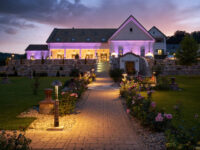Landscaping 101
Landscaping involves designing, modifying, and arranging outdoor spaces for aesthetic appeal and functionality. It includes plant selection, terrain assessment and modification, and incorporating non-living elements like water features, pergolas, and patios.
Lines impact landscape aesthetics – straight lines imply formality, while curves convey relaxation and natural ambience. Texture also matters: rough leaves create a rugged, natural look while smooth ones are more refined. Visit https://www.pristinecutslawncarellc.com to learn more.
Landscape design is an art form that harmonizes aesthetics and functionality to craft outdoor spaces that inspire. Using the principles of unity, proportion, balance, simplicity, variety, emphasis, and sequence, designers organize landscape elements for a harmonious composition that serves its purpose.
Proportion refers to the sizing relationship of landscape elements in relation to each other and to the size of a home. It is important to avoid overwhelming a landscape with large, overpowering pieces that detract from the overall appearance of the design. The principle of proportion also includes maintaining consistent size relationships among landscape components, such as planters, paths, and sidewalks.
Rhythm in landscape design creates movement and flow and draws the eye through (and around) the designed space. It can be achieved through symmetrical or asymmetrical balance. Symmetrical balance is achieved when opposite sides of the landscape contain mirror images of one another, while asymmetrical balance occurs when two opposite sides use different sizes and textures but share similar visual weights.
Color in landscape design adds dimension and provides harmony, contrast, and unity. It is important to choose the right colors to complement your home and surrounding landscape. Bright colors advance toward the viewer, while soft or neutral colors recede. Contrast is a key element in landscape design that draws attention to focal points. It is important to note that too much contrast can be unsettling, so it is best to use contrasting colors sparingly and with caution.
Unity is the force that binds landscape elements into a cohesive whole. It can be achieved through the repetition of a shape, texture, or color throughout the design. For example, a curved planter edging or a repeated pattern of flowers or stones on a walkway can create a sense of unity and make the house and landscaping feel like one.
Sustainability is a crucial aspect of landscape design that promotes eco-friendly and resource-efficient outdoor living spaces. Sustainable practices include water conservation, soil management, material resource conservation, and preservation of existing ecosystems. Techniques in water conservation may include addressing soil compaction, reducing runoff, and using efficient irrigation systems. Other sustainable aspects of landscape design include reducing the use of water-intensive turf, and using mulches to retain moisture.
Materials
The selection of materials to use in landscaping is an important part of designing your outdoor space. These materials should help you achieve the goals of your landscape design, while also meeting your budget and maintenance needs. The choice of material will also have an impact on the environmental sustainability of your landscaping project. Consider local and sustainable options, including wood products, sand, gravel, and mulches. Also, choose plants that are native to your region for maximum biodiversity value.
Hardscaping materials include non-living elements that provide structure and form to the landscape, such as walkways, patios, retaining walls, and gardens. These materials should be durable and complement the botanical features of the landscape. They should also be functional, allowing you to get in and out of your yard easily.
Landscaping materials can range from mulch to concrete to soils. Choosing sustainable landscape materials helps you avoid the negative effects of overuse and waste. The best way to do this is by choosing recycled or locally-sourced materials whenever possible. For instance, choosing pavers that are made from reclaimed granite or recycled bricks reduces the amount of embodied energy in your landscape project. Also, using regionally-sourced natural stone reduces carbon emissions due to transportation. Similarly, sourcing materials close to home eliminates the need for air transportation, which uses more fuel than trucks or trains.
Another sustainable option for paving is to use crushed rock instead of clay or concrete. This material provides a strong base for paving while also promoting drainage and providing stability. Also, it is less prone to cracking than other materials. Additionally, crushed rock has a lower embodied energy than asphalt and is cheaper to install.
Mulch is a sustainable landscaping material that provides a layer of protection for your garden plants. It slows the evaporation of moisture from the soil, reduces weed growth, and improves the overall health of your garden. However, you should avoid flammable mulches as they may burn or generate embers in the event of a wildfire.
Decorative stones add texture to your landscaping and can be used for borders, pathways, and focal points. Moreover, they are easy to maintain and require only occasional weeding and churning to keep them clean. They also absorb sunlight, which helps prevent excessive watering.
Plants
Landscaping requires more than just plants. You’ll also use a variety of hardscape elements, such as patios and pathways, to create the aesthetic and functional environment that your clients want. A landscaper with extensive knowledge of these features can help you choose the ones that will best suit your design and fit into your budget.
A landscaper’s eye for color, texture and shape is essential in commercial landscaping projects. For example, if your client wants to impress potential customers at their business’s entrance, a landscaper may suggest trees with interesting branching or shrubs that provide year-round interest. Plants with colorful autumn foliage, for example, are a good choice, as are those that offer winter interest such as dwarf nandina ‘Gulf Stream’ or red-leafed viburnum.
The right plant for a specific location makes all the difference. For instance, a company that wants to save on water bills might opt for low-water plants like hydrangeas and salvias. Or, a landscaper might use native plants that have evolved to thrive in local conditions. This helps the environment, too, as they typically need less water than exotic plants, reducing irrigation needs and the need for fertilizers.
Many business owners also seek to make their properties more eco-friendly. This can include installing rain gardens to capture runoff, allowing it to slowly infiltrate the soil rather than flooding streets and sewer systems. Another option is xeriscaping, which goes beyond plant selection to address the entire landscape with water conservation as a guiding principle.
Landscapers can also help business owners meet environmental goals with other features, such as green roofs that cover buildings or parking lots to reduce energy costs and create habitat for pollinators. Another option is sustainable paving, which uses recycled materials or other environmentally friendly products to reduce carbon footprints.
Landscaping professionals can keep up with industry trends to improve their skills and find new opportunities. For example, if the economy picks up, homeowners are more likely to spend money on their homes, including landscaping. This can provide opportunities for lawn care and landscaping companies, who can adjust their prices and keep up with inflation.
Maintenance
A beautiful landscape adds curb appeal and increases the value of a home or business. However, it requires regular maintenance to keep it looking its best. Whether it’s mowing the lawn, fertilizing shrubbery, or trimming trees and bushes, landscape maintenance (also known as groundskeeping) keeps your garden healthy and attractive.
Aesthetic Appeal
The primary reason to maintain your landscape is to preserve its beauty. A well-kept lawn, lush flower beds, and manicured trees create a welcoming impression on visitors and passersby. A well-maintained landscape is a great way to increase your property’s curb appeal and entice potential buyers if you plan to sell your home or business in the future.
Landscapers offer various services to maintain your landscape, including mowing, edging, mulching, and weed control. They also perform soil testing to determine the nutrient content and pH level of your dirt, then provide appropriate fertilizers. They may even recommend soil amendments to improve water retention and drainage.
Landscaping professionals also prune and trim plants, trees, bushes, and hedges to maintain their shape. This not only helps them grow in a healthy manner, but it also prevents overgrowth that can block sunlight and inhibit airflow, thereby decreasing the plant’s health.
In addition, landscaping maintenance includes aerating the lawn to promote root growth and reduce soil compaction. Aerating involves poking small holes into the dirt, which helps in promoting water, oxygen, and nutrients penetration to the roots. Lastly, they ensure proper irrigation management to avoid over-watering and reduce utility bills.
Landscape maintenance services also include weed control and disease prevention. Weeds compete with desired plants for water and nutrients, so they should be removed regularly to ensure a healthy garden. Diseases spread rapidly, so frequent inspections and prompt treatment are necessary to minimize their impact. Regular maintenance includes mowing and pruning to remove infected plants and removing fallen leaves to prevent the spread of pathogens. These measures help to prevent costly repairs and to protect your investment.






